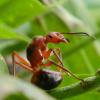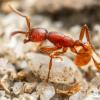so she has not shed her wings but I will make a small natural setup for her where she can forage
I have been successfully keeping a few Proceratium spp here in Knoxville. I have found that if you can collect a recently made egg sac, indicating the eggs are newly laid, of the common house spider that a colony and a newly established queen will take them. I collect from barns, basements etc and just regularly check female spiders and their webs and when a new sac appears I collect it. The ants will not take spider eggs that have advanced in their development. Parasteatoda tepidariorum, the common house spider.
do they do better in tubes, or in natural setups
I am currently housing them in small Petri dishes with soil from where they were collected. I have found this to be the wisest choice. I am currently working a preparing a culture care sheet to be uploaded. As I have noted before on this site the real issue is feeding them. I am currently culturing Parasteatoda tepidariorum as it is easier to culture than to scavenge for egg sacks. As noted above anecdotally I have observed that if the spider eggs are further along in development the ants will not accept them and since that is not easily determinable I chose to culture my own to have a constant supply of freshly laid eggs. I will continue to make notes and observations on this to determine if there is a specific egg age the ants prefer. As always I do not believe this is genus novices should try to culture, one should would work on ones techniques and commitment to housing easier cultured genera or species then move forward. Also, one should not be an "ant hog" and just grab as many varied genera or species as he or she is able, that is simply recklessness. Also note that Proceratium are cryptic so one may not simply observe them so if one is looking for an ant genus that is displayable or to be enjoyed like a Netflix video, then Proceratium is not the way to go.
She died last year, didn't accept any eggs that I knew were fresh, never shed her wings and died, I assume she was infertile, I am not really a novice as I've kept ants for 4 years now but i just didn't have information on the genus, my goal this year is to try to get more cryptics and broaden my experience with less common ants, I recently caught a strumigenys colony and have them in a natural setup, I have witnessed them actively foraging on the surface, I have my camponotus and formica to use as display, these guys are more of my research species to get observations on

















